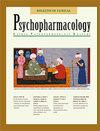不宁腿综合征在接受抗抑郁药或抗精神病药单一治疗的精神病患者中的患病率
Q Medicine
Klinik Psikofarmakoloji Bulteni-bulletin of Clinical Psychopharmacology
Pub Date : 2016-11-08
DOI:10.5455/BCP.20150908024954
引用次数: 7
摘要
目的:多巴胺阻断剂、镇痛药、抗组胺药等多组药物与不宁腿综合征(RLS)相关。虽然病例报告显示了一些重要的关系,但它们有许多方法上的局限性,如联合用药或医学合并症。本研究的目的是调查抗抑郁药(AD)或抗精神病药(AP)单一治疗的患者的RLS患病率和严重程度。方法:纳入197例患者和150例健康对照。根据国际不宁腿综合征研究组(IRLSSG)的标准诊断RLS。根据IRLSSG评定量表评定RLS的严重程度。被诊断为RLS的参与者进行了进一步的神经学和精神病学调查,以排除继发性原因。结果:AD治疗组120例(60.9%),AP单药治疗组77例(39.1%)。32例患者(16.2%)和7例对照(4.7%)根据IRLSSG标准诊断为RLS。抗精神病药物组最常见的RLS病因是喹硫平(28.5%),抗抑郁药物组最常见的是帕罗西汀(22.2%)。用药时间与RLS严重程度无统计学意义相关。结论:AD或AP诱发的RLS是一种常见疾病。在评估正在接受这两种药物治疗的精神病患者的RLS时,ad和APs应被视为引起RLS的原因。本文章由计算机程序翻译,如有差异,请以英文原文为准。
Prevalence of restless legs syndrome among psychiatric patients who are under antidepressant or antipsychotic monotherapy
Objective: Several groups of medications, such as dopamine blockers, analgesics and antihistaminergics were associated with restless legs syndrome (RLS). Although case reports showed some significant relations, they have many methodological limitations such as co-medications or medical co-morbidities. The aim of this study was to investigate the prevalence and severity of RLS in patients on antidepressant (AD) or antipsychotic (AP) monotherapy.
Methods: One hundred and ninety-seven patients and 150 healthy controls were included in the study. RLS was diagnosed according to the International Restless Legs Syndrome Study Group (IRLSSG) criteria. The severity of RLS was evaluated according to IRLSSG rating scale. Participants diagnosed with RLS went under further neurological and psychiatric investigation for excluding secondary causes.
Results: One hundred and twenty patients (60.9%) were on AD therapy, while 77 patients (39.1%) were on AP monotherapy. Thirty-two patients (16.2%) and seven controls (4.7%) were diagnosed with RLS according to IRLSSG criteria. The most frequent cause of RLS was quetiapine (28.5%) in the antipsychotic group and paroxetine (22.2%) in the antidepressant group. There was no statistically significant correlation between drug usage duration and RLS severity.
Conclusion: AD or AP induced RLS is a common condition. ADs and APs should be considered as a cause for RLS when assesing RLS in psychiatric patients who are under treatment either of these medications.
求助全文
通过发布文献求助,成功后即可免费获取论文全文。
去求助
来源期刊
CiteScore
0.34
自引率
0.00%
发文量
0
审稿时长
6-12 weeks

 求助内容:
求助内容: 应助结果提醒方式:
应助结果提醒方式:


